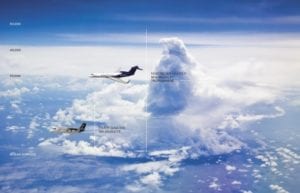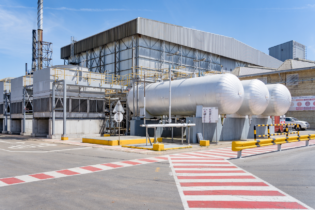
Two research planes on complementary missions flew over Guam measuring the levels of dozens of chemicals in the atmosphere in January and February 2014. Credit: Loretta Kuo/Shawn Honomichl
While efforts to limit ozone precursor emissions tend to focus on industrial activities and fossil fuel combustion in the United States and China, a new study suggests that future regulations may need to address the burning of forests and vegetation.
Fires burning in Africa, Asia cause high ozone in tropical Pacific
The study, which was published online January 13, 2016 in the journal
Nature Communications, indicates that these types of “biomass burning” may play a larger role in climate change than previously realised.
Based on observations from two aircraft missions, satellite data and a variety of models, an international research team showed that fires burning in tropical Africa and Southeast Asia caused pockets of high ozone and low water in the lower atmosphere above Guam–a remote island in the Pacific Ocean 1,700 miles east of Taiwan.
“We were very surprised to find high concentrations of ozone and chemicals that we know are only emitted by fires in the air around Guam,” said the study’s lead author Daniel Anderson, a graduate student in the University of Maryland Department of Atmospheric and Oceanic Science.
“We didn’t make specific flights to target high-ozone areas–they were so omnipresent that no matter where we flew, we found them.”
The study
For the study, two research planes on complementary missions flew over Guam measuring the levels of dozens of chemicals in the atmosphere in January and February 2014.
One aircraft flew up to 24 000 feet above the ocean surface during the U.K. Natural Environment Research Council’s Coordinated Airborne Studies in the Tropics (CAST) mission.
The other flew up to 48 000 feet above the ocean surface during the CONvective Transport of Active Species in the Tropics (CONTRAST) mission.
International collaboration is key
“International collaboration is essential for studying global environmental issues these days,” said CAST Principal Investigator Neil Harris of the University of Cambridge Department of Chemistry.
Researchers examined 17 CAST and 11 CONTRAST flights and compiled over 3,000 samples from high-ozone, low-water air parcels for the study. In the samples, the team detected high concentrations of chemicals associated with biomass burning–hydrogen cyanide, acetonitrile, benzene and ethyne.
Based on the results of this study, global climate models may need to be reassessed to include and correctly represent the impacts of biomass burning, deforestation and reforestation, according to UMD Professor Ross Salawitch, the study’s senior author and principal investigator of CONTRAST.
–
ScienceDaily.com








